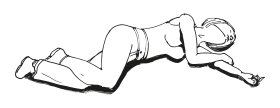
Back وضع الإفاقة Arabic Posició lateral de seguretat Catalan Zotavovací poloha Czech Stabile Seitenlage German Posición lateral de seguridad Spanish Kylkiasento Finnish Position latérale de sécurité French Stabile sydlizzing Frisian Stabil oldalfekvés Hungarian Stabila flanko-posturo IO
| Recovery position | |
|---|---|
 All forms of the recovery position share basic principles. The mouth is downward so that fluid can drain from the patient's airway; the chin is well away from the throat to keep the epiglottis opened. Arms and legs are nested to stabilize the position of the patient |
In first aid, the recovery position (also called semi-prone) is one of a series of variations on a lateral recumbent or three-quarters prone position of the body, often used for unconscious but breathing casualties.
An unconscious person, a person who is assessed on the Glasgow Coma Scale (GCS) at eight or below, in a supine position (on the back) may not be able to maintain an open airway as a conscious person would.[1] This can lead to an obstruction of the airway, restricting the flow of air and preventing gaseous exchange, which then causes hypoxia, which is life-threatening. Thousands of fatalities occur every year in casualties where the cause of unconsciousness was not fatal, but where airway obstruction caused the patient to suffocate.[2][3] This is especially true for unconscious pregnant women; once turned on to their left side, pressure is relieved on the inferior vena cava, and venous return is not restricted. The cause of unconsciousness can be any reason from trauma to intoxication from alcohol.
It is not necessarily used by health care professionals, as they may have access to more advanced airway management techniques, such as tracheal intubation.
- ^ Bartle, C; Levitan, R (January 2010). "Airway Establishment and Control". Merck Online Manuals: Critical Care Medicine.
- ^ "First aid 'could save thousands'". BBC News. 2010-04-12.
- ^ "Be the difference". GMTV. 2010-04-11. Archived from the original on 2010-04-17.
© MMXXIII Rich X Search. We shall prevail. All rights reserved. Rich X Search